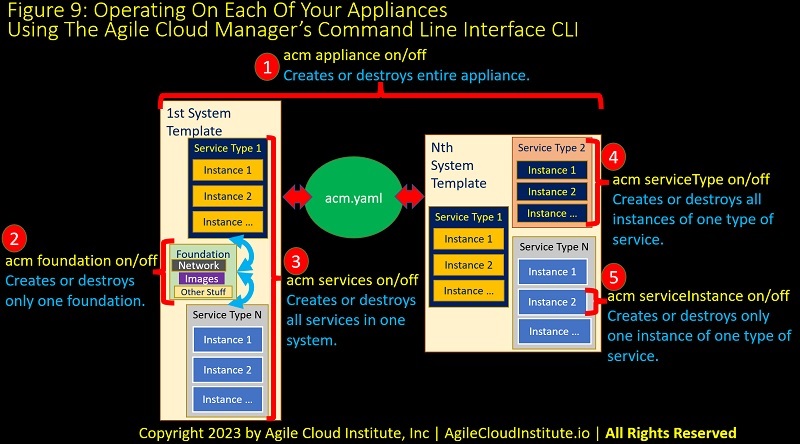Architecting the Agile Enterprise with the Agile Cloud Manager
Part 9 of 16: Operating On Your Appliances Using The Agile Cloud Manager’s Command Line Interface CLI
Twelve operations can be performed using the Command Line Interface CLI offered by the Agile Cloud Manager. Ten of these are business-level operations that can operate surgically on your appliances, and the remaining two operations are for setting up the Agile Cloud Manager.
Figure 9 is entitled “Operating On Each Of Your Appliances Using The Agile Cloud Manager’s Command Line Interface”.

Figure 9 illustrates how the ten business-level operations are performed by 5 specific pairs of commands which each interact with a specific level of an appliance that is modeled using the Agile Cloud Manager.
The ten business-level operations are on/off switches for 5 levels of the appliances and systems that you have seen in the diagrams above so far in this article. These 5 levels and 10 commands are referenced by numbers 1 through 5 in the diagram and are:
Number 1 in the diagram is “acm appliance on/off”, which you can see operates on the entire appliance.
acm appliance oninstalls the entire appliance in one single commandacm appliance offdestroys the entire appliance in one single command
Number 2 in the diagram is “acm foundation on/off”, which operates on one foundation.
acm foundation on <flags>creates only the foundation of only one systemacm foundation off <flags>destroys only the foundation of only one system
Number 3 in the diagram is “acm services on/off”, which operates on all the services in one system.
acm services on <flags>creates all the services for only one system. This means creating all the instances of every type of service defined in the system configuration.acm services off <flags>destroys all the services for only one system. This means destroying every instance of every type of service defined in the system configuration.
Number 4 in the diagram is “acm serviceType on/off”, which operates on only one type of service.
acm serviceType on <flags>creates all the instances of only one type of service for only one system.acm serviceType off <flags>destroys all the instances of only one type of service for only one system.
Number 5 in the diagram is “acm serviceInstance on/off”, which operates on only 1 instance of a service.
acm serviceInstance on <flags>creates only one specific instance of only one specific type of service in only one system.acm serviceInstance off <flags>destroys only one specific instance of only one specific type of service in only one system.
In addition, and not visible in the diagram, there is “acm setup on/off” which together enable the Agile Cloud Manager to work from any sufficiently provisioned Windows or Linux computer that is sufficiently connected to the internet.
acm setup on <flags>prepares a computer to operate on an appliance. This includes retrieving all the various repositories of templates that will be orchestrated into the specific appliance. But note you must provision the compute instance properly before runningacm setup on <flags>.acm setup offremoves all the things that theacm setup ondownloaded
These 12 commands together give you the ability to operate on your business at a high-level.
These 12 commands enable you to abstract away huge amounts of technical complexity, so that it becomes easier to drive change in your business.
These 12 commands enable you to reduce the cost of your IT organization because everything below these 12 commands can be organized into reusable templates that can be:
- Put under Agile project management.
- Governed by your enterprise governance systems.
Next: Proceed to Part 10 of 16
back to Site Home
back to Architecture section Home
Back to Part 8 of 16